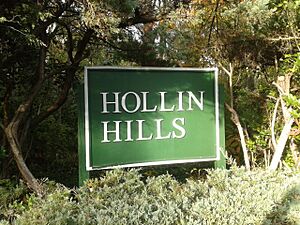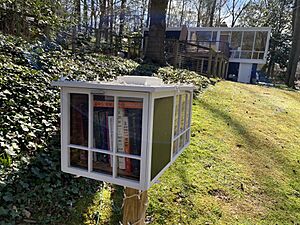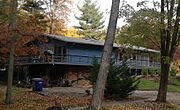Hollin Hills facts for kids
|
Hollin Hills Historic District
|
|

Example of Unit Type No. 5B home constructed in 1954 designed by architect Charles M. Goodman in Hollin Hills neighborhood
|
|
| Location | Fort Hunt area of Fairfax County, roughly Beechwood, Elba, Glasgow, Martha's, Paul Springs, Range & Stafford Rds., Mason Hill, Rebecca & Whiteoaks Drs., Alexandria, Virginia |
|---|---|
| Area | 326 acres (132 ha) |
| Built | 1946 (land acquired) 1949–1971 (home builds) |
| Built by | Davenport, Robert C. |
| Architect | Goodman, Charles M. |
| Architectural style | Modern Movement |
| Website | www.hollinhills.org |
| MPS | Historic Residential Suburbs of the United States, 1830–1960 |
| NRHP reference No. | 13000807 |
Quick facts for kids Significant dates |
|
| Added to NRHP | September 30, 2013 |
Hollin Hills is a special neighborhood in southeast Fairfax County, Virginia. It's known for its unique homes and beautiful natural spaces. This community has over 30 acres (12 ha) of parks, a swimming pool, and sports courts. A group called the Civic Association of Hollin Hills (CAHH) helps manage these areas.
The neighborhood was mostly designed by Charles M. Goodman and built by Robert C. Davenport. This happened between 1949 and 1971. It was one of the first places in the Washington, D.C. area to feature modern architecture after World War II. The homes were built to blend in with the natural landscape.
Davenport bought the first 225 acres (91 ha) of land in the 1940s. Later, he added another 101 acres (41 ha) in 1956. In total, about 450 modern houses were built here. These homes were different from the usual Colonial Revival style in the area. Today, Hollin Hills is famous for its mid-century modern architecture. Each house is placed on its lot to offer privacy and great views of nature.
The Hollin Hills Historic District covers 326 acres (132 ha). It includes 468 important buildings and several parks and recreation spots. It was recognized on the Virginia Landmarks Register and the National Register of Historic Places in 2013. This means it's a special place that helps tell the story of our country's history.
Contents
History of Hollin Hills
How Hollin Hills Got Started
When Robert Davenport bought the land for Hollin Hills, he chose the name as a nod to the nearby 18th-century Hollin Hall Plantation. This plantation was once owned by George Mason, one of the Founding Fathers of the United States. Mason named his land after an estate his mother's family owned in England. Some of the original Hollin Hall plantation buildings are still standing today.
Modern Homes and Design
Davenport hired Charles M. Goodman, a famous architect from Washington, D.C., to design the community. Goodman also designed the Washington National Airport. In 1950, Goodman brought in landscape architect Lou "Barney" Voigt. This team of builder, architect, and landscape designer worked together. They made sure each home had a lot at least one-third of an acre in size.
Between 1949 and 1961, Charles Goodman created eight main house designs for Hollin Hills. These designs had different sizes and features. During construction, many trees were kept to create privacy. Houses were also built at angles to give residents their own space. The homes became very popular, especially with their large glass windows. This made Goodman a well-known expert in modern architecture.
Some streets in Hollin Hills were named to fit the community's theme. Others were named after Davenport's family members, like Martha's Road for his mother and Rebecca Drive for his daughter. Elba Road was even named after one of his prize bulls!
Over time, some custom homes and additions were built, making Hollin Hills like an "architectural laboratory" for modern design. One special home on Elba Road was part of the "Alcoa Care-free Homes" project in 1957. Only 23 of these aluminum-heavy homes were built across the U.S., and Hollin Hills has one that has been restored.
Nature and Environment
In 1950, Goodman hired Lou "Barney" Voight, a landscape designer, to create plans for the homes. These plans helped each house fit perfectly with the rolling hills and natural woods. After Voight's death, other designers like Daniel Urban Kiley continued this work. They focused on making the homes and land work together beautifully. Today, residents can even find copies of their original landscape plans from places like the Library of Congress.
The water in Hollin Hills flows into the Little Hunting Creek. This creek then leads to the Potomac River and finally to the Chesapeake Bay. In 2021, Fairfax County started projects to fix and stabilize the streams in Goodman and Brickelmaier Parks. These projects aimed to make the parks safer and healthier for nature. The parks reopened in November 2022.
Getting Around and Services
Transportation in Hollin Hills
Most people in Hollin Hills use cars to get around. Many houses don't have traditional garages. Instead, they have carports, which are covered spaces for cars. Some older homes also have gravel parking areas near the street. Fairfax County has rules about parking large vehicles like RVs or boats on public streets.
The Virginia Department of Transportation (VDOT) takes care of most public roads in Fairfax County. For public transport, the Fairfax Connector bus service has stops nearby. The closest train station is the Huntington station for the Washington Metro system. The nearest airport is Ronald Reagan Washington National Airport (DCA), about 8 miles north.
Community Services
Fairfax County handles trash and recycling collection for Hollin Hills. Dominion Energy provides electricity, and Washington Gas supplies natural gas to homes that use it. The Fairfax County Water Authority (Fairfax Water) provides clean drinking water and water for fire hydrants.
For internet, TV, and phone services, residents can choose from companies like Comcast, Cox, and Verizon.
Learning and Libraries
Schools in the Area
In 1954, construction began on Hollin Hills Elementary School right next to the community entrance. It opened in 1955. The school became desegregated in 1964. However, student numbers dropped, and the school closed in 1980. The building is now a retirement community.
Today, students in Hollin Hills attend Fairfax County Public Schools (FCPS). The local public schools are Hollin Meadows Elementary School, Sandburg Middle School, and West Potomac High School. There are also private schools nearby, like Bishop Ireton High School and St. Stephen's & St. Agnes School.
For books and learning, the closest public libraries are the Sherwood Regional Library and Martha Washington Library. These are part of the Fairfax County Public Library system. Many residents have also set up their own "Little Free Library" book exchanges in the neighborhood. These often look like tiny versions of the modern homes found in Hollin Hills!
Community Life
Civic Association of Hollin Hills (CAHH)
The Civic Association of Hollin Hills (CAHH) is a group of volunteers who work to make the community better. It's run by a board of directors elected by the residents. The CAHH organizes many activities and events. They publish a monthly newsletter, manage the 30 acres (12 ha) of parkland, and oversee the Hollin Hills Pool and Hollin Hills Pickleball and Tennis Club. They also hold a special "House and Garden Tour" every two years.
Parks and Green Spaces
Volunteers from the CAHH Parks Committee and the Friends of Hollin Hills help take care of the parks. They work to improve park features and remove harmful plants like English ivy. Hollin Hills has seven main parks:
- Paul Spring Park: A 6.38 acres (2.58 ha) park along Paul Spring Road.
- Voigt Memorial Park: A 9.772 acres (3.955 ha) area with the Hollin Hills Pool, pickleball, and tennis courts. It also has a playground and a bocce court.
- McCalley Park: A small 0.351 acres (0.142 ha) park named after Charles R. “Mac” McCalley, who was the construction foreman for Hollin Hills.
- Charles Goodman Park & Trail: This park is named after the neighborhood's main architect. It's 3.2029 acres (1.2962 ha) and follows a stream.
- Brickelmaier Park & Trail: This 3.104 acres (1.256 ha) park was renamed in honor of George Brickelmaier, an early resident. It's mostly forested land along a stream.
- Wildlife Sanctuary: A 2.785 acres (1.127 ha) area that was planned for homes but never developed. It's now a peaceful wildlife area.
- Sutton–Potter Park: A 5.37 acres (2.17 ha) park at the western edge of Hollin Hills.
Swim and Racquet Clubs
Goodman and Davenport originally wanted to build a shopping center in Hollin Hills. But the county didn't approve it. So, the land became home to the Hollin Hills Pool, and tennis and pickleball courts. The Hollin Hills Pool & Swim Club opened in 1954. The Hollin Hills Swim Team, called the Bluefish, started in 1956 and is part of a big swim league.
In 1955, a tennis club was formed, and four courts were built. In 2022, six pickleball courts were added on top of two of the tennis courts. Both the swim and racquet clubs offer memberships for residents and non-residents.
There's also the Hollin Meadows Swim and Tennis Club nearby. It's a separate private club with a 5-acre complex.
Awards and Recognition
- Examples of architecture in Hollin Hills
Hollin Hills has won many awards for its architecture and landscape design. In 1950, it received the Revere Quality House award. More than 25 years later, it won the first Test-of-Time Award from the Virginia Society of the American Institute of Architects (AIA). This award recognized its lasting appeal in how homes were placed and designed.
In 1972, Hollin Hills was included in Fairfax County's Inventory of Historic Sites. This was its first major recognition as a historic community. In 2013, Hollin Hills was added to the Virginia Landmarks Register. Soon after, in September 2013, it was also listed as a National Register of Historic Places national historic district. This means it's recognized as a very important historic place across the country.
| Year | Title | Organization | Notes |
|---|---|---|---|
| 1950–51 | Certificate of Merit | Revere Home Program sponsored by the Southwest Research Institute Housing Research Foundation | Certified Quality House Program |
| 1951 | "Best Houses under $15,000” | Life magazine | Life (September 10, 1951 edition) awards Unit Type No. 2 homes |
| 1951 | Certificate of Merit | Southwest Research Institute | Hollin Hills named "Nation's Outstanding Development; Charles Goodman named "Architect of the Year"; Robert C. Davenport named "Builder of the Year" |
| 1950–51 | Best Homes for Family Living | Parents magazine | Award presented at the National Association of Home Builders (Jan 1952) and published in the Parents Feb 1952 edition |
| 1954 | Award of Merit | American Institute of Architects (AIA) National Honor Award | Original Square house design, 7322 Rebecca Dr |
| 1954 | Most Advanced Builder House | House & Home, The Magazine of Building | Unit Type 5A |
| 1955 | Award of Merit | AIA Washington–Metropolitan Chapter | |
| 1955 | National Award | AIA | |
| 1955 | The Evening Star–AIA Award for Residential Architecture | AIA Washington–Metropolitan Chapter | Class 1 - Custom Designed Homes for Owner Occupancy Class 2 - Development Houses for Sale or Rent |
| 1956 | The Evening Star–AIA Award for Residential Architecture | AIA Washington–Metropolitan Chapter | Unit Type 5CS at 1241 Rebecca Dr (M. E. Odoroff Residence) |
| 1957 | The Evening Star–AIA Award for Residential Architecture | AIA Washington–Metropolitan Chapter | Development house category: 1216 Rebecca Dr (Joseph R. Lane Residence) Remodeled house category: 410 Paul Spring Rd (Mr. & Mrs. Martin M. Rosen Residence); architect for remodeling (Casper S. Neer) Remodeled house category: 1 Bedford Ln (Mr. & Mrs. William Welch Residence); architect for remodeling (Casper S. Neer) |
| 1957 | Merchant Built winners of Homes for Better Living Awards | AIA in cooperation with House and Home, Better Homes and Gardens, and NBC | * Award of Merit–7322 Rebecca Dr (Mr. and Mrs. Jeremy Hodson) * Honorable Mention–607 Sherwood Hall Ln |
| 1957 | Best Homes for Family Living - Special Merit Award for Distinctive Design | Parents magazine | 407 Brentwood Pl (R. Randall Vosbeck Residence) |
| 1957 | AIA Regional Award Competition | AIA | * Award of Merit–1241 Rebecca Dr (M. E. Odoroff Residence) * Honorable Mention–607 Sherwood Hall Ln (Residence) |
| 1957 | AIA Centennial Exhibit—100 Years of American Architecture | AIA | Selected as one of ten "Milestones in future of American Architecture" exhibit at National Gallery of Art |
| 1958 | Exhibit of U.S. Architecture | International Union of Architects (French: Union internationale des Architectes; UIA) |
5th UIA World Congress (held in Moscow, Russia) |
| 1961 | Better Living: A Sensible Buy in the Suburbs | Life magazine | Review by archtitect critic Paul Rudolph on pg. 114, 116 |
| 1976 | Award of Excellence | The Washington Post | "Let the Sun Shine In" |
| 1972 | Fairfax County's Inventory of Historic Sites | Fairfax County, Virginia | |
| 1981 | Test-of-Time Award | AIA Virginia Society | Hollin Hills awarded the inaugural Test-of-Time Award (Residential Award) |
| 1989 | Design Award for Continuing Contributions to Community Appearance | Northern Virginia Community Appearance Alliance | |
| 1997 | Award for Excellence (2) | AIA Virginia Society, and AIA Northern Virginia Chapter |
for an addition to the Killpatrick residence, 2117 Paul Spring Rd, designed by architect Matt Poe |
| 2004 | Historic Residential Suburbs in the United States MPD, 1830–1960 | National Register of Historic Places (NHRP) National Park Service |
Listed at national level of multiple property designation. |
| 2005 | Honorable Mention | Fairfax County Exceptional Design Awards | |
| 2010 | ‘Mad Men’ Look Contest 2010 - 3rd place | The Washington Post | K. Smith residence |
| 2012 | ‘Mad Men’ Look Contest 2012 - Winner | The Washington Post | Unit Type 5CS at Kimbro St (D. Rivera and J. Hall-Rivera residence) |
| 2013 | Virginia Landmarks Register | Virginia Department of Historic Resources | 029-5471 Hollin Hills Historic District |
| 2013 | National Register of Historic Places (NRHP) historic district | National Register of Historic Places (NHRP) National Park Service |
326-acre suburban development under Criteria A and C with a period of significance from 1946 to 1971; 475 homes as contributing structures |
| 2015 | Hollin Hills Historic District, Ronald F. Lee residence (1949–60) | National Register of Historic Places (NHRP) National Park Service |
Criteria B addendum for 1805 Drury Lane |
| 2018 | Historic American Buildings Survey (HABS) | Heritage Documentation Programs National Park Service |
Extensive drawings, photographs and written reports on:
|
| 2022 | Fairfax County Environmental Excellence Award | Fairfax County Office of Environmental and Energy Coordination | Elisabeth Lardner, CAHH Parks Committee (Individual County Resident Category) |
| 2022 | Historic Overlay District (HOD) designation | Fairfax County Board of Supervisors |
Famous Residents
Over the years, Hollin Hills has been home to many interesting people. These include artists, architects, and even people who work in government or law. Some notable residents have included:
- Reginald Bartholomew—a diplomat who represents his country abroad
- Gilbert Wheeler Beebe—an epidemiologist and statistician who studies diseases and numbers
- James Carroll—an author, historian, and journalist
- Joseph Carroll—a military officer (Lt. General) and one of the first people to live in Hollin Hills
- Bernard B. Fall—a war reporter and expert on Southeast Asia
- Roberta Flack—a famous singer
- Noel Gayler—a naval officer (Admiral) and director of the National Security Agency
- Philip Hirschkop—a civil rights lawyer
- Paul Krizek—a politician in the House of Delegates
- Ronald F. Lee—a key person in the national historic preservation program
- James G. O'Hara—a former U.S. Representative in Congress
- Pat Roberts—a retired U.S. Senator
- Salvatore R. Martoche—a judge and government official
- Gil Scott-Heron—a jazz poet and musician
- David McCullough—a well-known author
- William "Bill" Green Miller—an ambassador
- Richard M. Moose—a business executive and diplomat
- Carl C. Mose—a sculptor
- Helen W. Nies–a judge
- Steve Novosel—a jazz bassist and educator
- Michael Sorkin—an architect and writer about cities
- Kathleen Mary Spagnolo—an artist








